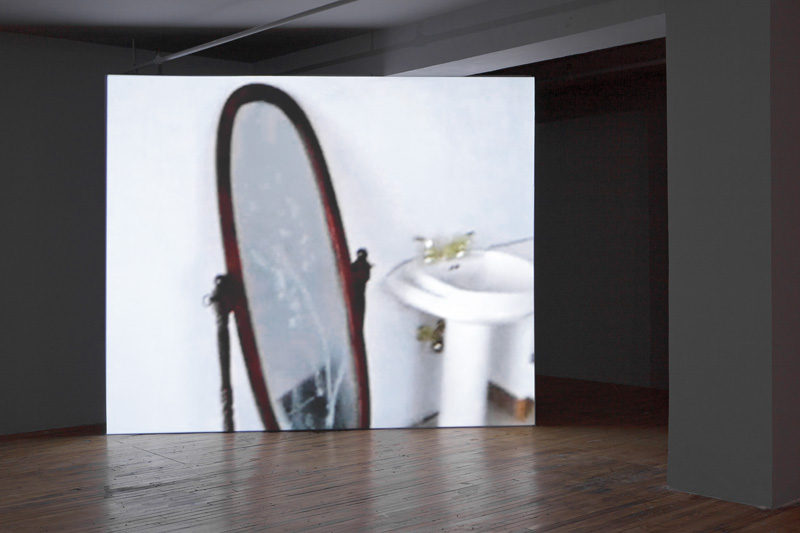[Fall 2011]
Centre des arts actuels Skol, Montreal
January 14 to February 12, 2011
With Monologue, Patrick Ward has skilfully edited together a pool of handheld footage culled from video-sharing Web sites. In silence, a single and anonymous viewpoint scans, probes, and travels through a labyrinthine interior. As the viewer follows, ambling down dark halls, peering into basements, moving from room to room, an impossible ruin begins to take form. Ward’s exhibition is the first part of Skol’s novel thematic program, Unknown Artist. Conceptualized and curated by Bernard Schütze, the series is based on the shared imagining of an anonymous artist, described by Schütze as a nomadic Acephal-like figure with a particular sense of futurity. Monologue has been employed to delimit a territory for this personage.
Discussing the work in a video interview produced by Skol, Ward indicated that Monologue emerged directly from the experience of browsing the video-sharing Web sites from which the constitutive parts of the work are drawn. Commencing from a single video documenting an abandoned space, the artist navigated through a bank of related videos generated by the Web sites and soon recognized that with each subsequent viewing he traced a path through these remote spaces. The documentation collected served any numberof purposes: some cameras were carried by those who aimed to penetrate the space, with the excitement (and aggression) of trespassing; others were wielded by passers-by making an unannounced survey of decline; and still others were put to more formal uses, such as documentation for legal and fiscal purposes by real-estate agents or for insurance claims.
Architectural metaphors concerning the virtual, volatile, and potential spaces yielded by an on-line life are today not revelatory in themselves. Hyperlinks may very well be read as thresholds, but Ward has transposed these linkages back into a cinematic vernacular. He looked toward Alfred Hitchcock’s 1948 film Rope, in which a series of extended scenes are edited together to give the effect of appearing as a single shot. As Hitchcock choreographed his edits to fall as the camera’s view was blocked, so Ward calculated his edits to occur at opportune moments. In Monologue, spaces are sutured together when the frame settles on a threshold, when the image is overwhelmed by a ray of sunlight or overtaken by darkness, or when swift and jerky movements render the image briefly indiscernible. In his article “Nostalgia for Ruins,” theorist Andreas Huyssen posits that “nostalgia can be a utopia in reverse.1”
Ruins can serve as devices of memory in which critical inquiry and desire intersect. Using the example of the fantastic ruins drafted by Giovanni Battista Piranesi in the eighteenth century, Huyssen suggests that nostalgia for the utopian project of modernity emerged within, and even welcomed, the era. Accordingly, we might read Ward’s impossible ruin as a regretful glance at the ravages of late capitalism. An accumulation of footage of this nature easily conjures the spirit of the recent global economic crisis. Ward’s careful editing weaves a past of affluence, stability, and activity together with a present of desertion, decay, and regression. In following the circuitous route of the footage, we are trailing the path of capital.
This teasing out of a critique of neolib-eralism is partially the result of a consideration of what Ward has chosen to leave out, principally the videos’ audio tracks. Here, silence is enforced to foreground issues of the cinematic, privileging the projected image and its correspondence with the gallery environment. The overall installation of Monologue requests that visitors mirror the lateral navigation underway in the projected video – from the entrance on the side, with the projection partially obscured, to the end of negotiating their position within the darkened room. With the videos’ more discordant elements discarded, the evidence of their conditions of production is obscured, thus keeping an explicit political position at bay.
Yet, the work’s silence also contributes to another architectural notion, that of imprisonment. Huyssen’s study of Piranesi’s ruins extended into a consideration of the artist’s invented prisons. In these renderings, the spectator’s gaze is “lured in and cap-tured” by an unfixed perspective, a complicated built environment that suspends all “possibility of an outside.” Within Piranesi’s work, Huyssen argues, fragmentation and montage are not entirely emancipatory strategies. Rather, they remain character-istics of melancholia, as history, memory, and desire commingle within their multitudinous combinations and contradictions.
Considering this, Monologue remains a reticent work, overdetermined by its formal achievements. Yet, the work marks a turning point in Ward’s oeuvre. With Monologue, he has commenced to move away from the tug-and-pull fetishism and critique of cinematic technologies, rituals, and tropes that defined his earlier works. As reticent as it may be, Monologue kicks up the dust of history, a musty and melancholic haze behind each of Ward’s precise edits.
Robin Simpson is a curator and art-history student based in Montreal. As a graduate student, he has presented papers at numerous academic conferences, notably Traffic: Conceptualism in Canada, hosted by the Justina M. Barnicke Gallery in 2010. His research interests focus on the social determinants of art and art communities, with particular attention paid to art after 1960. He most recently contributed to a catalogue published by the Art Gallery of Nova Scotia on the work of Halifax artist Stephen Kelly. He is also co-founder of Pavilion Projects, a nomadic and often symbiotic curatorial and arts service initiative.

